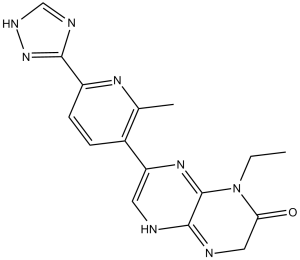CC-115
This product is for research use only, not for human use. We do not sell to patients.

For small sizes, please check our retail website as below: www.invivochem.com
| Size | Price | Stock |
|---|---|---|
| 250mg | $1250 | Check With Us |
| 500mg | $1850 | Check With Us |
| 1g | $2775 | Check With Us |
Cat #: V2567 CAS #: 1228013-15-7 Purity ≥ 98%
Description: CC-115 (CC115) is a novel and potent dual inhibitor of DNA-PK (DNA-dependent protein kinase) and mTOR (mammalian target of rapamycin) with IC50s of 13 nM and 21 nM, respectively and with potential antineoplastic activity.
Top Publications Citing Invivochem Products
Publications Citing InvivoChem Products
Product Promise

- Physicochemical and Storage Information
- Protocol
- Related Biological Data
- Stock Solution Preparation
- Quality Control Documentation
| Molecular Weight (MW) | 336.35 |
|---|---|
| Molecular Formula | C16H16N8O |
| CAS No. | 1228013-15-7 |
| Storage | -20℃ for 3 years in powder formrr |
| -80℃ for 2 years in solvent | |
| Solubility In Vitro | DMSO: 67 mg/mL (199.2 mM)rr |
| Water: <1 mg/mLrr | |
| Ethanol: <1 mg/mL | |
| Synonyms | CC115 ; CC-115; CC 115; 1-ethyl-7-(2-methyl-6-(1H-1,2,4-triazol-5-yl)pyridin-3-yl)-3,4-dihydropyrazino[2,3-b]pyrazin-2(1H)-one |
| Protocol | In Vitro | CC-115 inhibits PC-3 cells proliferation with an IC50 of 138 nM. In a kinase selectivity assessment against a panel of 250 protein kinases at 3 μM, only one kinase other than mTOR kinase is identified with more than 50% inhibition (cFMS 57%, IC50=2.0 μM).PI3K-alpha (IC50=0.85 μM), ATR (50% inhibition at 30 μM) and ATM (IC50>30 μM). The IC50 values for CC-115 are >10 μM against a panel of CYP enzymes and >33 μM for the hERG (human ether-a-go-go-related gene) ion channel. When screened in a single point assay at 10 μM against a Cerep receptor and enzyme panel only one target is inhibited >50% (PDE3, IC50=0.63 μM);CC-115 proves to be equipotent against DNA PK (IC50=15 nM) and demonstrates 40 to >1000 fold selectivity against the remaining PIKKs teste. |
|---|---|---|
| In Vivo | CC-115 shows good in vivo PK profiles across multiple species with 53%, 76% and ~100% oral bioavailability in mouse, rat and dog, respectively. CC-115 is tested at lower doses of 0.25, 0.5 and 1 mg/kg bid or 1 mg/kg qd, with observed corresponding tumor volume reductions of 46%, 57%, 66% and 57% respectively. CC-115 sustains inhibition though 24 hours. At the 1 mg/kg dose CC-115 shows significant inhibition at 1 and 3 hours, CC-115 demonstrating inhibition through 10 hours. CC-115 is evaluated using both once (qd) and twice (bid) daily dosing schedules |
These protocols are for reference only. InvivoChem does not
independently validate these methods.
| Solvent volume to be added | Mass (the weight of a compound) | |||
|---|---|---|---|---|
| Mother liquor concentration | 1mg | 5mg | 10mg | 20mg |
| 1mM | 2.9731 mL | 14.8655 mL | 29.7309 mL | 59.4619 mL |
| 5mM | 0.5946 mL | 2.9731 mL | 5.9462 mL | 11.8924 mL |
| 10mM | 0.2973 mL | 1.4865 mL | 2.9731 mL | 5.9462 mL |
| 20mM | 0.1487 mL | 0.7433 mL | 1.4865 mL | 2.9731 mL |
The molarity calculator equation
Mass(g) = Concentration(mol/L) × Volume(L) × Molecular Weight(g/mol)
Mass
=
Concentration
×
Volume
×
Molecular Weight*
The dilution calculator equation
Concentration(start)
×
Volume(start)
=
Concentration(final)
×
Volume(final)
This equation is commonly abbreviated as: C1 V1 = C2 V2
Concentration(start)
C1
×
Volume(start)
V1
=
Concentration(final)
C2
×
Volume(final)
V2
Step One: Enter information below
Dosage mg/kg
Average weight of animals g
Dosing volume per animal µL
Number of animals
Step Two: Enter the in vivo formulation
%DMSO
+
%
+
%Tween 80
+
%ddH2O
Calculation Results:
Working concentration:
mg/ml;
Method for preparing DMSO master liquid:
mg
drug pre-dissolved in
µL
DMSO(Master liquid concentration
mg/mL)
,Please contact us first if the concentration exceeds the DMSO solubility of the batch of drug.
Method for preparing in vivo formulation:
Take
µL
DMSO master liquid, next add
µL
PEG300, mix and clarify, next add
µL
Tween 80,mix and clarify, next add
µL
ddH2O,mix and clarify.
Note:
- (1) Please be sure that the solution is clear before the addition of next solvent. Dissolution methods like vortex, ultrasound or warming and heat may be used to aid dissolving.
- (2) Be sure to add the solvent(s) in order.




































